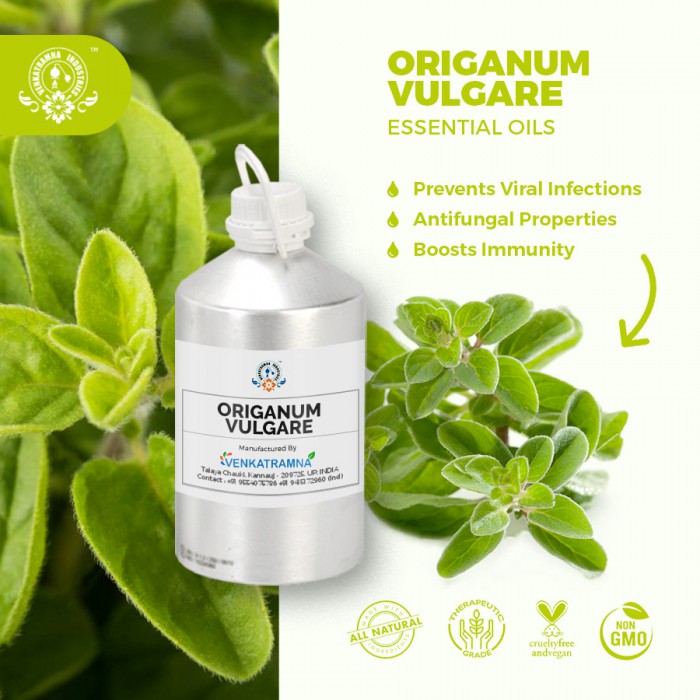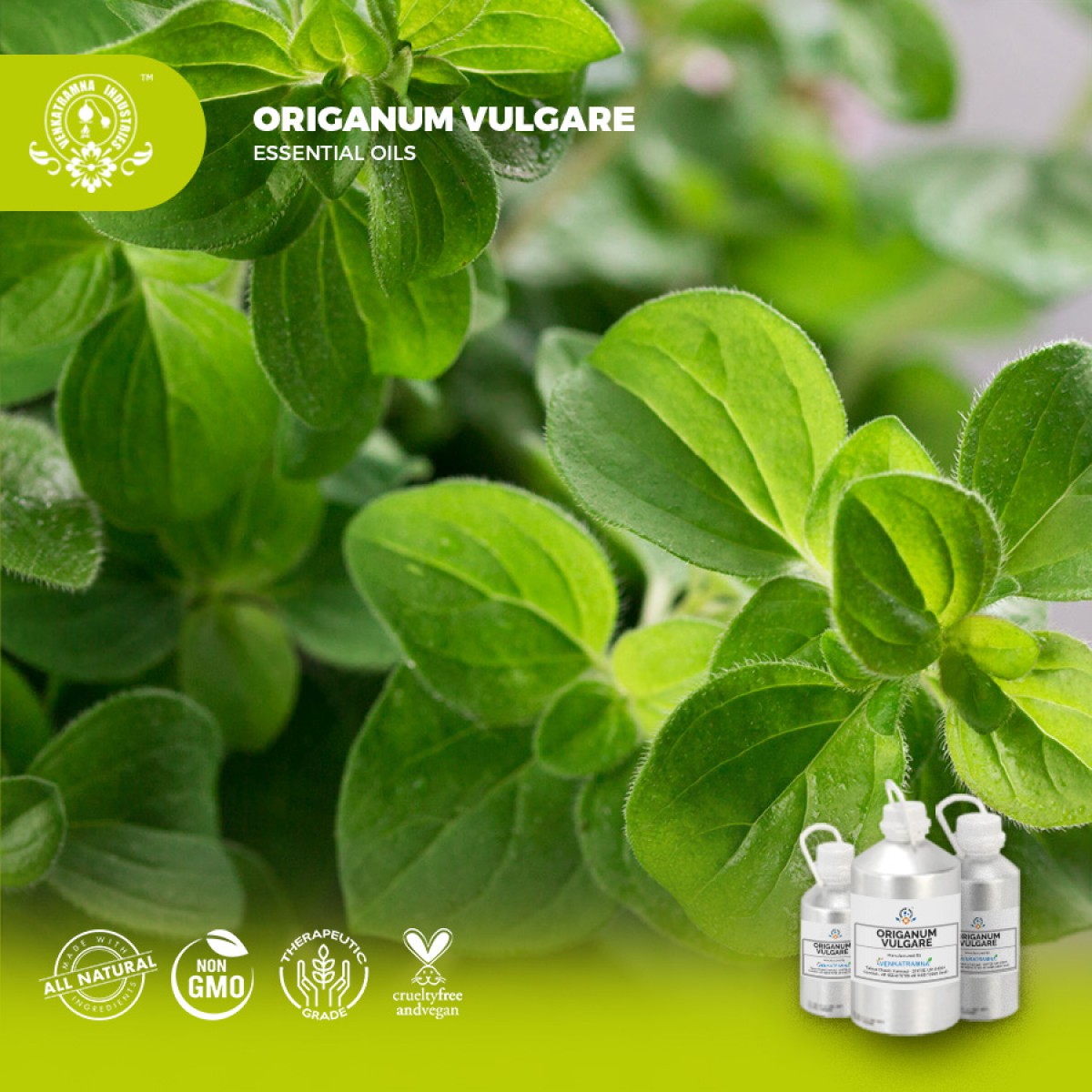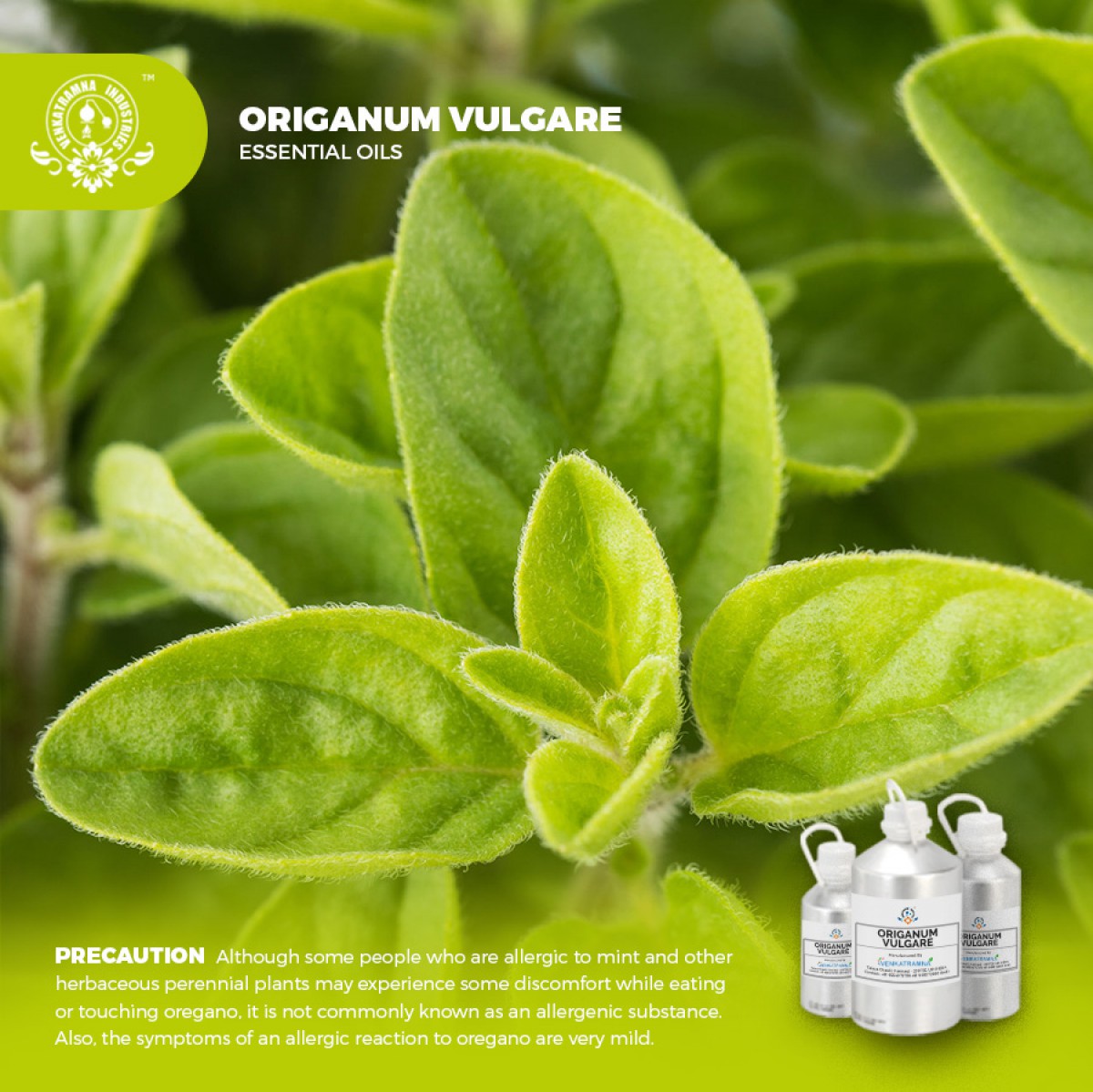Botanical Name: Origanum Vulgare L Common name: Origano, Marjoram Read More
|
Botanical Name: |
Origanum
Vulgare L |
|
Common name: |
Origano,
Marjoram |
|
Plant
family: |
Verbenaceae |
|
Genus: |
Origanum |
|
Appearance/Color: |
Pale yellow to reddish or brownish liquid with thin consistency |
|
Odor: |
It has
a spicy but dry and woody aroma with earthy notes with strong aroma at a middle
note. |
|
Blends With: |
Herbal and woody essential oils such as Cypress, Marjoram,
Rosemary, and the more camphorous floral oils such as Lavender. |
|
Origin: |
Spain |
|
Source: |
Leaves and Stem |
|
Method
of Extraction: |
Steam
Distillation |
Origanum
Vulgare is also known as Oregano and Wild Marjoram. The name originated from
the Greek ‘joy of the mountains’ and is a common mint species family. It is
native to the Mediterranean basin and Asia. It is a perennial herb which grows
20–80 cm tall, with leaves of up to 4 cm, and has purple, spikey flowers.
Oregano has been a popular culinary herb in Europe since ancient time, and
became popular in North America after WWII when returning soldiers posted to
Italy brought back a taste for pizza.
Oregano was first used by Greeks since it was originally grown in Greece. They believed that this herb was created by the Goddess Aphrodite. She wanted it to be a symbol of joy growing in her garden. The word “oregano” comes from the Greek words oros, for “mountain,” and ganos, for “joy” meaning “joy of the mountains.
DISCLAIMER
The complete range of conditions
or methods of use are beyond our control therefore we do not assume any
responsibility and expressly disclaim any liability for any use of this
product. Information contained herein is believed to be true and accurate however,
all statements or suggestions are made without warranty, expressed or implied,
regarding accuracy of the information, the hazards connected with the use of
the material or the results to be obtained from the use thereof. Compliance
with all applicable federal, state, and local laws and local regulations
remains the responsibility of the user.
The FDA has not evaluated the
statements on this website. No claims are made by Venkatramna Industries as to
the medicinal value of any products from vriaroma.com or by us. The information
presented here is for educating our customers about the traditional uses of
essential oils and is not intended to diagnose, treat, cure, or prevent any
disease. You are responsible for understanding the safe application of these products.
If you have any questions, please call or email us for further information.
As per NAHA guidelines, New Directions Aromatics
(NDA) does not recommend the ingestion of essential oils. It is imperative to
consult a medical practitioner before using Essential Oils for therapeutic
purposes. Pregnant and nursing women and those taking prescription drugs are
especially advised not to use this product without the medical advice of a
physician. The oil should always be stored in an area that is inaccessible to
children, especially those under the age of 7.
The ancient Egyptians used it in food
preservation, and Hippocrates used it in his medical practice.
Traditionally Origano
is used for respiratory tract disorders such as
coughs, asthma, croup, and bronchitis. It is also used for
gastrointestinal (GI) disorders such as heartburn and bloating.
Other uses include treating menstrual cramps, rheumatoid arthritis,
urinary tract disorders including urinary tract infections (UTIs),
headaches and heart conditions.
Origanum vulgare essential oil is antibiotic, antiseptic, antiviral
and antifungal medicinal oil. It clears respiratory infections in a few days
only. It is also a proven antifungal that can be used in the treatment of
Candida Albicans. For fungus under the nails and on the skin, eczema and
psoriasis it can be used diluted in olive oil with topical application, as well
as in baths. It can be used for the treatment of rheumatic pains and muscle aches.
Origanum vulgare essential oil can heal all kinds of infections, viral, bacterial or fungal in nature. It is also a powerful analgesic and antioxidant, useful in muscular and rheumatic pains, stomach and intestinal upsets.
In foods and beverages,
origanum vulgare essential oil is used as a culinary spice and a food
preservative.
Origanum vulgare
essential oil contains chemicals that might help reduce cough and spasms. It also
helps digestion by increasing bile flow and fighting against some bacteria,
viruses, fungi, intestinal worms, and other parasites.
Origanum vulgare
essential oil is taken by mouth for intestinal parasites, allergies, sinus pain, arthritis, cold
and flu, swine flu, earaches, and fatigue. It is applied to
the skin for skin conditions including acne, athlete's
foot, oily skin, dandruff, canker sores,
warts, ringworm, rosacea, and psoriasis as well as for insect
and spider bites, gum disease, toothaches, muscle pain,
and varicose veins. The oil is also used topically as insect repellent.
COMMON
USAGE
·
Boosts
Immunity
·
Prevents
Viral Infections
·
Antifungal
Properties
·
Prevents
Infections
·
Anti-inflammatory
Properties
·
Treats
Respiratory Conditions
·
Acts
as Antiparasitic
·
Prevents
Cancer
·
Regulates
Menses
·
Anti-allergenic
·
Promotes
Digestion
Ingredients:
|
S.No |
Key Constituents |
Strength (%) |
|
1 |
Carvacrol |
61.6–83.4 |
|
2 |
p-Cymene |
4.9–9.7 |
|
3 |
g-Terpinene |
3.8–8.2 |
|
4 |
Thymol |
0–4.4 |
|
5 |
b-Caryophyllene |
1.4–2.5 |
|
6 |
a-Pinene |
0.5–2.2 |
|
7 |
b-Myrcene |
0–1.9 |
|
8 |
a-Terpinene |
0.8–1.4 |
Safety Summary
·
Hazards: Drug
interaction; inhibits blood clotting; embryotoxicity; skin irritation (low
risk); mucous membrane irritation.
·
Contraindications: Pregnancy, breastfeeding
·
Cautions:
Dermal -
Hypersensitive, diseased or damaged skin for children under two years of age.
Oral -
Diabetic medication, anticoagulant medication, major surgery, peptic ulcer,
hemophilia, other bleeding disorders.
Maximum
dermal use level - 1.1%.
Safety advice Our dermal maximum is based on 87.8% total
thymol and carvacrol content and a dermal limit of 1% for carvacrol and thymol
to avoid skin irritation.
Organ Specific Effects
·
Adverse skin reaction: Undiluted Origanum oil was severely
irritating to mice, and moderately irritating to rabbits. Tested at 2% on 25
volunteers it was neither irritating nor sensitizing. Origanum oil is
non-phototoxic (Opdyke 1974 p945– 946). In a CAM (chorioallantoic membrane of
the fertile chicken egg) assay, a model for detecting irritants, Origanum
onites oil with 57.4% carvacrol and 11.6% thymol was strongly irritating. This
irritation was due to thymol and not to carvacrol.
·
Reproductive toxicity: When Origanum vulgare oil was fed to
pregnant mice for two weeks at 1,000 ppm (equivalent to 150 mg/kg), there was a
related increase in the rate of embryonic cell death. Satureja khuzestanica, an
essential oil consisting of 93.9% carvacrol, was given orally to pregnant rats
during gestational days 0–15 at doses of 100, 500 or 1,000 ppm. There were no
signs of maternal toxicity or teratogenicity at any dose, and in the two higher
dose groups there was a significant increase in the number of implantation and
live fetuses, a positive outcome.
Systemic
Effects
·
Acute
Toxicity: Origanum oil acute
oral LD50 in rats 1.85 g/kg; acute dermal LD50 in rabbits 480 mg/kg.
·
Antioxidant/pro-oxidant activity: Origanum vulgare L. subsp. hirtum oil
displayed antioxidant activity in chicken liver, muscle tissue and egg yolk
(Dorman et al 1995) and was significantly antioxidant (comparable with
a-tocopherol or BHT) in three different assays (Kusilic et al 2004). The oil
scavenged DPPH radicals with an IC50 of 0.17 mg/mL (Bozin et al 2006). Thymbra
capitata oil had more than double the antioxidant potency of BHT in sunflower
oil.
· Carcinogenic/anti carcinogenic potential: Carcinogenic/anticarcinogenic potential
Origanum oil significantly induced glutathione S-transferase activity in mouse
tissues (Lam & Zheng 1991). Origanum onites oil (74.0% carvacrol, 7.2%
linalool, 4.4% thymol) was not mutagenic in S. tymphimurium strains TA98 and
TA100 with or without S9, and strongly inhibited induced mutagenicity in the
same strains (Ipek et al 2005). Thymbra capitata oil was not mutagenic in
either the Bacillus subtilis rec-assay or the Salmonella/microsome reversion
assay (Zani et al 1991). Origanum vulgare L. subsp. hirtum oil is reported to
be non-genotoxic and antigenotoxic (Bakkali et al 2006; Mezzoug et al 2007). An
Origanum vulgare L. subsp. hirtum oil with 79.6% carvacrol caused complete cell
death in two human cancer cell lines, Hep-2 and HeLa, at 0.01% (Sivropoulou et
al 1996). Carvacrol displays anticarcinogenic activity.
·
Drug interactions: Antidiabetic or anticoagulant medication,
because of cardiovascular effects.
·
Ecotoxicity: No data available
Acute fish toxicity: LC50 / 96 HOUR – No data
available
Toxicity to aquatic plants – No data available
Toxicity to microorganisms – No data available
·
Toxicity threshold – No data available
·
Bioaccumulation: unlikely
·
Mobility in soil: No data available
·
Persistence and degradability: biodegradation
expected
·
PBT and vPvB assessment: No data available
·
Avoid direct exposure into water streams and
ground water sources.





 MSDS-Origanum.pdf
MSDS-Origanum.pdf




